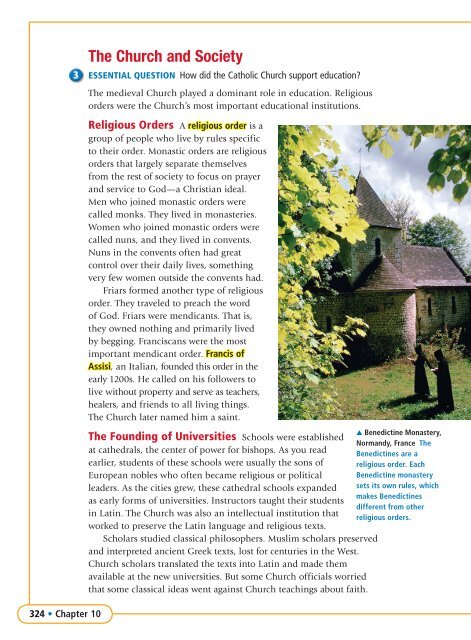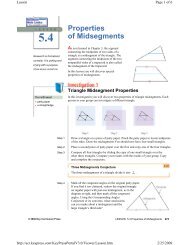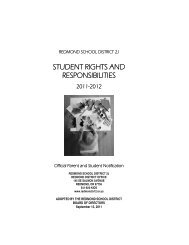Medieval Europe and the Ottoman Empire - Redmond School District
Medieval Europe and the Ottoman Empire - Redmond School District
Medieval Europe and the Ottoman Empire - Redmond School District
You also want an ePaper? Increase the reach of your titles
YUMPU automatically turns print PDFs into web optimized ePapers that Google loves.
324 • Chapter 10<br />
The Church <strong>and</strong> Society<br />
ESSENTIAL QUESTION How did <strong>the</strong> Catholic Church support education?<br />
The medieval Church played a dominant role in education. Religious<br />
orders were <strong>the</strong> Church’s most important educational institutions.<br />
Religious Orders A religious order is a<br />
group of people who live by rules specific<br />
to <strong>the</strong>ir order. Monastic orders are religious<br />
orders that largely separate <strong>the</strong>mselves<br />
from <strong>the</strong> rest of society to focus on prayer<br />
<strong>and</strong> service to God—a Christian ideal.<br />
Men who joined monastic orders were<br />
called monks. They lived in monasteries.<br />
Women who joined monastic orders were<br />
called nuns, <strong>and</strong> <strong>the</strong>y lived in convents.<br />
Nuns in <strong>the</strong> convents often had great<br />
control over <strong>the</strong>ir daily lives , something<br />
very few women outside <strong>the</strong> convents had.<br />
Friars formed ano<strong>the</strong>r type of religious<br />
order. They traveled to preach <strong>the</strong> word<br />
of God. Friars were mendicants. That is,<br />
<strong>the</strong>y owned nothing <strong>and</strong> primarily lived<br />
by begging. Franciscans were <strong>the</strong> most<br />
important mendicant order. Francis of<br />
Assisi Assisi, an Italian, founded this order in <strong>the</strong><br />
early 1200s. He called on his followers to<br />
live without property <strong>and</strong> serve as teachers,<br />
healers, <strong>and</strong> friends to all living things.<br />
The Church later named him a saint.<br />
▲ Benedictine Monastery,<br />
The Founding of Universities <strong>School</strong>s were established<br />
Norm<strong>and</strong>y, France The<br />
at ca<strong>the</strong>drals, <strong>the</strong> center of power for bishops. As you read Benedictines are a<br />
earlier, students of <strong>the</strong>se schools were usually <strong>the</strong> sons of religious order. Each<br />
<strong>Europe</strong>an nobles who often became religious or political Benedictine monastery<br />
leaders. As <strong>the</strong> cities grew, <strong>the</strong>se ca<strong>the</strong>dral schools exp<strong>and</strong>ed sets its own rules, which<br />
makes Benedictines<br />
as early forms of universities. Instructors taught <strong>the</strong>ir students<br />
different from o<strong>the</strong>r<br />
in Latin. The Church was also an intellectual institution that<br />
religious orders.<br />
worked to preserve <strong>the</strong> Latin language <strong>and</strong> religious texts.<br />
Scholars studied classical philosophers. Muslim scholars preserved<br />
<strong>and</strong> interpreted ancient Greek texts, lost for centuries in <strong>the</strong> West.<br />
Church scholars translated <strong>the</strong> texts into Latin <strong>and</strong> made <strong>the</strong>m<br />
available at <strong>the</strong> new universities. But some Church officials worried<br />
that some classical ideas went against Church teachings about faith.








